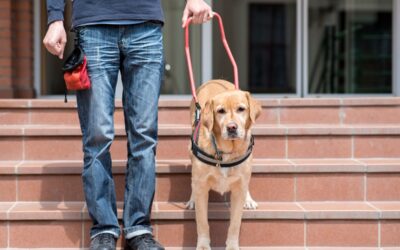Top 10 Psychiatric Service Dog Breeds for Mental Well-being


What Are Psychiatric Service Dogs?
10 Best Psychiatric Service Dog Breeds
1. Labrador Retriever – Best Psychiatric Service Dog Breed For Anxiety and Depression
Physical Characteristics
- Average Lifespan: 10-12 years
- Nature: Friendly, calm, and loyal
- Height: 21.5-24.5 inches (at the shoulder)
- Weight: 55-80 pounds
Health and Care
- Health Monitoring: Labs are prone to hip dysplasia, obesity, and ear infections.
- Exercise Needs: High; requires daily physical activity to stay healthy.
- Coat Care: Moderate grooming; they have a double coat that sheds seasonally.
Cost of Maintenance
- Average Cost: $80 – $150 per month
2. Golden Retriever – Best Psychiatric Service Dog Breed for PTSD
Physical Characteristics
- Average Lifespan: 10-12 years
- Nature: Gentle, friendly, and intelligent
- Height: 21.5-24 inches (at the shoulder)
- Weight: 55-75 pounds
Health And Care
- Health Monitoring: Prone to hip dysplasia, cancer, and heart issues.
- Exercise Needs: High; needs regular physical activity to stay mentally and physically healthy.
- Coat Care: Regular grooming is required to manage their thick, double-layered coat.
Cost Of Maintenance
- Average Cost: $90 – $160 per month
3. Poodle – Best Psychiatric Service Dog Breed for Alzheimer’s Disease and Dementia
Physical Characteristics
- Average Lifespan: 12-15 years
- Nature: Intelligent, active, and loving
- Height: 10-18 inches (at the shoulder)
- Weight: Standard Poodle ~ 40-70 pounds, Miniature Poodle ~ 10-15 pounds, Toy Poodle ~ 4-6 pounds
Health And Care
- Health Monitoring: Monitor for hip dysplasia, epilepsy, and progressive retinal atrophy.
- Exercise Needs: Moderate to high; requires mental stimulation along with physical exercise.
- Coat Care: Regular grooming is needed to maintain their hypoallergenic coat.
Cost Of Maintenance
- Average Cost: $70 – $150 per month
4. German Shepherd – Best Psychiatric Service Dog Breed For Panic Disorders and Hypervigilance
Physical Characteristics
- Average Lifespan: 9-13 years
- Nature: Protective, loyal, and intelligent
- Height: 22-26 inches (at the shoulder)
- Weight: 50-90 pounds
Health And Care
- Health Monitoring: Prone to hip dysplasia, degenerative myelopathy, and bloat.
- Exercise Needs: High; requires extensive physical activity and mental stimulation.
- Coat Care: Regular brushing needed to manage shedding.
Cost Of Maintenance
- Average Cost: $100 – $170 per month
5. Cavalier King Charles Spaniel – Best Psychiatric Service Dog Breed for Social Anxiety Disorder
Physical Characteristics
- Average Lifespan: 12-15 years
- Nature: Affectionate, gentle, and alert
- Height: 12-13 inches (at the shoulder)
- Weight: 13-18 pounds
Health And Care
- Health Monitoring: Prone to heart disease, syringomyelia, and eye conditions.
- Exercise Needs: Moderate; daily walks and playtime are necessary.
- Coat Care: Regular grooming to keep their coat clean and tangle-free.
Cost Of Maintenance
- Average Cost: $70 – $120 per month
6. Border Collie – Best Psychiatric Service Dog Breed for Bipolar Disorder and ADHD
Physical Characteristics
- Average Lifespan: 12-15 years
- Nature: Intelligent, energetic, and alert
- Height: 18-22 inches (at the shoulder)
- Weight: 30-45 pounds
Health And Care
- Health Monitoring: Monitor for hip dysplasia, epilepsy, and collie eye anomaly.
- Exercise Needs: Very high; requires a lot of physical and mental activity.
- Coat Care: Regular brushing required to manage shedding.
Cost Of Maintenance
- Average Cost: $80 – $140 per month
7. Boxer – Best Psychiatric Service Dog Breed for Panic Disorders
Physical Characteristics
- Average Lifespan: 10-12 years
- Nature: Playful, loyal, and protective
- Height: 21.5-25 inches (at the shoulder)
- Weight: 50-80 pounds
Health And Care
- Health Monitoring: Prone to hip dysplasia, heart conditions, and cancer.
- Exercise Needs: High; needs daily physical activity to maintain health.
- Coat Care: Low grooming needs due to their short coat.
Cost Of Maintenance
- Average Cost: $80 – $150 per month
8. Pomeranian – Best Psychiatric Service Dog Breed for Depression and Emotional Numbness
Physical Characteristics
- Average Lifespan: 12-16 years
- Nature: Affectionate, alert, and lively
- Height: 6-7 inches (at the shoulder)
- Weight: 3-7 pounds
Health And Care
- Health Monitoring: Watch for dental issues, collapsed trachea, and patellar luxation.
- Exercise Needs: Moderate; enjoys short walks and playtime.
- Coat Care: Regular grooming and brushing are needed to manage thick, double coats.
Cost Of Maintenance
- Average Cost: $60 – $100 per month
9. Bernese Mountain Dog – Best Psychiatric Service Dog Breed for PTSD and Severe Anxiety
Physical Characteristics
- Average Lifespan: 6-8 years
- Nature: Gentle, loyal, and calm
- Height: 23-28 inches (at the shoulder)
- Weight: 70-115 pounds
Health And Care
- Health Monitoring: Monitor for hip dysplasia, bloat, and elbow dysplasia.
- Exercise Needs: Moderate; regular walks and light activities.
- Coat Care: Frequent grooming is required to manage shedding.
Cost Of Maintenance
- Average Cost: $100 – $180 per month
10. Great Dane – Best Psychiatric Service Dog Breed for Chronic Depression and Panic Disorders
Physical Characteristics
- Average Lifespan: 7-10 years
- Nature: Gentle, calm, and affectionate
- Height: 28-34 inches (at the shoulder)
- Weight: 100-200 pounds
Health And Care
- Health Monitoring: Prone to bloat, hip dysplasia, and heart issues.
- Exercise Needs: Moderate; needs regular but low-intensity exercise.
- Coat Care: Low grooming needs due to their short coat.
Cost Of Maintenance
- Average Cost: $100 – $200 per month
How to Select the Right Psychiatric Service Dog?
1. Understand Your Needs
2. Consider the Dog’s Temperament
3. Evaluate the Breed’s Suitability
4. Size and Living Conditions
5. Energy Levels and Exercise Needs
Conclusion
Frequently Asked Questions
What Tasks Can a Psychiatric Service Dog Perform?
Can I Train My Own Psychiatric Service Dog?
Yes, you can train your own psychiatric service dog. The dog must be trained to perform specific tasks that assist with your mental health condition and be well-behaved in public settings, as required under ADA guidelines.
How Long Does It Take To Train a Psychiatric Service Dog?
Can Any Breed Be a Psychiatric Service Dog?
Where Can I Get a Psychiatric Service Dog?
Are Psychiatric Service Dogs Allowed in All Public Places?
Do Psychiatric Service Dogs Need Special Training For Public Access?
How Can I Get My Psychiatric Service Dog Registered?
Do You Need a Prescription To Get a Psychiatric Service Dog?
Yes, a licensed mental health professional must provide a PSD letter or recommendation stating that a psychiatric service dog is necessary to assist with your mental health condition. This letter is essential to prove your need for the dog.
Are Psychiatric Service Dogs Covered By Insurance?
Post Author
Prince Sharma
Related Articles
Man With Schizophrenia Manages Symptoms With The Help Of A Psychiatric Service Dog
How PSD Helps Manage Symptoms of Schizophrenia?A Psychiatric Service Dog helps manage schizophrenia symptoms by providing emotional support, grounding the individual during hallucinations, and assisting in crisis situations. PSDs offer stability...
Why Do You Need a Psychiatric Service Dog ID Card?
Why Do You Need a Psychiatric Service Dog ID Card?A psychiatrist service dog ID card is not required by the ADA, but it can be helpful in communicating to others that your dog is a trained service animal. A PSD Letter makes it possible.In...
Anxiety and Psychiatric Service Dogs: What You Need To Know.
How Psychiatric Service Dogs Help Manage Anxiety: A Complete GuidePsychiatric service dogs help manage anxiety by providing emotional support and performing specific tasks tailored to their handler's needs. They can detect early signs of anxiety,...
Live and Fly Free with Your PSD!






